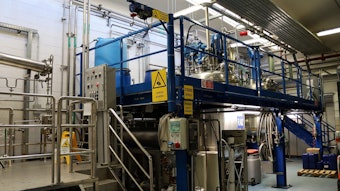Volatile energy costs and increased pressure from consumers to be more socially responsible are important business drivers for manufacturers in the home and personal care (HPC) industries. But identifying the potential savings of reducing utilities consumption is not a trivial task. Manufacturing processes are interlinked, and plant-floor layouts have grown larger and more complex over the years to meet changing market demands. As a result, the realities of today’s manufacturing landscape present a multifaceted challenge for manufacturers to identify, prioritize and execute the changes necessary to optimize energy usage.
By conducting an energy and utilities audit that takes a holistic view of manufacturing processes, HPC manufacturers can more easily identify energy losses in order to prioritize savings potential. As a result, cost and consumption of all utilities reductions can be realized and plant performance optimized. In fact, by teaming utilities specialists—such as plant and facility operations directors with domain professionals, such as the lead controls engineer and an internal sustainability champion—you can gain a comprehensive view of the production process from generation to consumption. This helps make sure that production is completed under optimum conditions at the lowest cost possible and that no utilities are wasted in the process.
Conducting an Audit of Utilities Used Production
When beginning the audit process, you’ll want to work with a team of specialists to identify and develop the business goals for your energy management strategy. These goals should be easily quantifiable, such as an overall percent reduction in energy usage or a specific percent improvement in the facility’s energy spend.
Some of these savings can be achieved with simple changes to equipment, usage patterns or technology updates. Longer term changes may involve process overhauls, or perhaps an entire facility redesign. However, all energy audit programs should incorporate the establishment of an energy awareness culture across all areas of the plant. The most successful energy management programs are those that are continuous. Regular audits are an excellent method for keeping employees motivated to continue effective savings programs. Indeed, determining the scope and level of commitment to more effective energy management upfront will focus efforts on the areas with the most opportunity for substantial positive returns.
The next step of an audit process should include an analysis of overall consumption to identify areas of opportunity. As part of this analysis, a certified energy manager (CEM), who has successfully completed their CEM certification exams administered by the Association of Energy Engineers (AEE), should complete an in-depth analysis of the facility’s current energy usage. Using data collected on-site from the in-house team and a comprehensive review of all utility bills for the past two years, the CEM can generate an analysis output document that provides a broad, high-level overview of the company’s current utilities usage.
While the CEM can use general benchmark goals (see Table 1) to help develop the final analysis, his or her experience is crucial in taking into account local conditions—such as the size of the plant, the degree of automation, the impact of seasonal differences, and even special terms and conditions in utilities contracts. Each of these variables can significantly impact a manufacturer’s specific energy savings potential.
The final analysis, together with your team’s knowledge and experience, will form the basis for a collaborative investigation of the energy consumption within individual areas of the plant.
Collectively Synchronizing Generation Against Demand
Once your critical objectives are paired with the areas of opportunity, a more in-depth examination of the processes can start. A CEM will work with you to complete a walking tour of the facility. On the generation side, he or she will evaluate the efficiency of boilers, chilled water systems and air compressors, analyze the water/wastewater streams and systems, and explore the possibility of installing alternative systems, such as coupled heat and power (CHP) plants or solar panels.
On the consumption side, application and domain professionals can compare the current processes in place against the latest technologies available in the market to identify potential savings by investing in newer technologies. The deployment of new processes can result in reduced energy costs as well as in increased capacity, shortened cycle times or reduced product losses.
Although it is important that the individual processes are examined for their energy consumption, it is equally important that optimization of the individual processes is not completed in isolation. The CEM can help your in-house team develop an energy management plan that allows for the appropriate synchronization of processes to provide multiple benefits from one action. For example, heat exchange from cooling down a product in one process can deliver the heat needed for processes at another stage of production. Scheduling each of these steps in the manufacturing process, with respect to the energy they consume and the energy available through the utilities systems, can reduce spikes in electricity consumption and avoid surcharges on energy prices.
Identifying the Savings Opportunities
Each of the opportunities identified in an energy audit can generally be classified as one of three changes to the manufacturing process:
- Behavioral changes: Behavioral changes are simple, low- or no-cost solutions that can significantly impact the bottom line, such as changes in the time of day certain equipment is used, or timing power-up sequencing for off-peak hours. Payback for behavioral changes is generally immediate and the savings drops straight to the bottom line.
- Programming changes: Programming changes are relatively low-cost changes to the facility’s energy-consuming assets that can provide a quicker payback. On the plant floor, these changes can take the form of improving controls or upgrading older equipment for more effective use of energy resources. Payback for programming changes is generally realized in less than one year.
- Capital investments: Capital investments can include boilers with advanced process control that helps optimize fuel usage; installing solar panels or other alternative energy systems to power manufacturing machinery; and building an entirely new, more sustainable plant. While these are the most expensive options—payback can stretch beyond one year—the long-term ROI also can be the most rewarding.
Examples from an audit conducted for a large batch manufacturer can illustrate the different categories and typical actions pertaining to each. As part of audit process, Rockwell Automation recommended behavioral changes as simple as instituting an energy consumption awareness program with their workforce. The analysis recommended setting easily identifiable metrics for success, including a 1% reduction in overall energy consumption. It was estimated that these small improvements—ranging from just 1-5% improvements, in most cases—could help the company save significantly on energy costs year over year.
The audit also identified potential savings resulting from shifting time-of-day operation for equipment to off-peak hours to reduce peak demand charges. By charging the batteries used to power their forklifts at night instead of in the middle of the day, the company could realize $35,000 in demand charge savings annually.
The programming changes identified for this same batch manufacturer included several updates to their compressed air system, which was comprised of two 750 standard cubic feet per minute, 150-horsepower air compressors. These compressors ran 24/7 at full power—even when the plant was in a down condition on the weekends or during holidays.
Recommended programming changes to this system included reducing line pressure to the minimum psi required by non-operating devices when the plant was in a down condition, and powering those devices that must stay on during weekends and holidays with smaller, dedicated compressors. The audit analysis also recommended reducing the line pressure during operational periods to the minimum level necessary to complete the manufacturing process. All told, these programming changes had the potential to save the manufacturer almost $50,000 annually.
As part of the project, the CEM also made a capital investment recommendation pertaining to the compressed air system. The analysis showed that by installing an air buffer tank or additional storage tanks, the manufacturer could further reduce peak loads and therefore reduce overall load and cycling of the compressors.
Other capital investment recommendations ranged from investing in variable frequency drives for the air handlers in the plant’s HVAC system, to upgrading the boiler controls for burner management, combustion control and heat recovery alternatives. However, because these projects potentially require greater capital investment, they must be weighed against other business goals and longer-term production requirements.
Overall, the audit process identified over $240,000 in potential savings for the manufacturer. In tough economic times, those bottom-line savings can mean stability and risk mitigation. As the economy improves, the optimized production processes can mean improved margins and a significant competitive advantage.
Bottom Line: Monitor
In addition to the behavioral, programming and capital investment changes that a holistic utilities audit will bring to light, the monitoring of energy usage is a crucial component to a successful ongoing energy management program. Each individual department in the plant is often not aware of its consumption on a daily, weekly or even monthly basis. This is a crucial aspect, because you cannot control what you cannot measure and you cannot optimize what you cannot control. By simply metering the consumption of utilities, small opportunities for improvement can be identified that can provide a significant impact on energy usage, resulting in immediate financial savings.
Stephen Stokes from AMR Research points out in his article titled “Sustainability, Green, and the Greenback: Where’s the Money in a Sustainability Management Ecosystem?” that “targets and tracking are crucial. Leading organizations set targets and regularly report their successes in attaining those goals.”
An effective monitoring system should provide the following benefits:
- Automatic reporting of Key Performance Indicators (KPI)
- Statistical analysis capability
- Easier configuration of user reports
- Scalable
- Presentation of real-time performance data in graphical form
Ability to communicate with existing site SCADA or other control systems Relevant performance data should be presented to the people who are most likely to immediately respond to out-of-specification performance (utility or process operations staff)
The information generated from monitoring software can be trended and correlated to exogenous factors (such as local temperature and humidity) and can provide the highest level of utilities management available. Systems that track usage for the entire enterprise allow employees at all levels of the organization to have a common understanding of energy use. This can help focus efforts on improvement potential and drive consistent organizational behavior in achieving sustainable production goals.
Manufacturers in the HPC industry are facing increased demand from consumers to produce their products in a sustainable manner. Using a system-wide approach to examining energy consumption through the use of in-house experience and outside energy consultants can provide the best overall recommendations for building a successful energy management strategy. By implementing this strategy and engaging the entire workforce in efforts to waste less and save more, you can improve their bottom line and increase your brand equity, all while better serving the community and environment.










